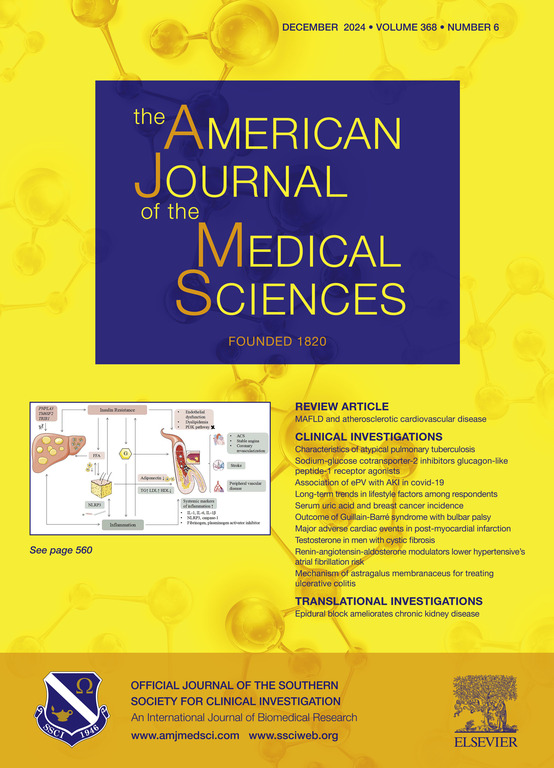An observational study of the causes of an isolated elevated alkaline phosphatase level of unclear etiology
IF 2.3
4区 医学
Q2 MEDICINE, GENERAL & INTERNAL
引用次数: 0
Abstract
Background
Serum alkaline phosphatase (ALP) is a commonly obtained laboratory test, but its diagnostic specificity is limited because it is found in multiple tissues. We investigated patients with isolated, elevated, ALP levels without an obvious etiology at presentation to determine the frequency of different causes of an isolated elevated ALP.
Methods
This was a retrospective, cohort study of adults (age >18 years old) from January 1st, 2013, to June 30th, 2020 in both the in- and outpatient setting at the Medical University of South Carolina. 260 patients with an isolated, elevated ALP of unknown etiology (patients with known biliary obstruction, underlying parenchymal liver disease, or pregnancy were excluded) were included. A secondary outcome was mean survival time from the ALP result.
Results
The most common cause of ALP elevation was due to underlying malignancy (147, 57 %), with 61 patients having infiltrative intrahepatic malignancy, 52 patients having bony metastasis, and 34 patients having both hepatic and bone metastasis. Bone disease (75, 29 %), unsuspected parenchymal liver disease (18, 7 %), non-malignant infiltrative liver disease (7, 2 %), and other disorders (13, 5 %) accounted for the remainder of the cohort. Notably, 123 of 260 (47 %) patients died within an average of 58 months after identification of isolated, elevated ALP.
Conclusions
An isolated, elevated ALP of unclear etiology is associated with several very specific and important disorders, in particular metastatic intrahepatic malignancy - and is uncommonly associated with primary parenchymal liver disease. Providers should be aware of the potential clinical significance of an elevated ALP.
病因不明的孤立性碱性磷酸酶水平升高原因观察研究
背景:血清碱性磷酸酶(ALP)是一种常见的实验室检测指标,但其诊断特异性有限,因为它存在于多种组织中。我们对发病时无明显病因的孤立性 ALP 水平升高的患者进行了调查,以确定引起孤立性 ALP 升高的不同病因的频率:这是一项回顾性队列研究,研究对象为 2013 年 1 月 1 日至 2020 年 6 月 30 日在南卡罗来纳医科大学住院和门诊就诊的成年人(年龄大于 18 岁)。研究共纳入了 260 名病因不明的孤立性 ALP 升高患者(排除已知胆道梗阻、潜在实质性肝病或妊娠患者)。次要研究结果是ALP结果的平均存活时间:ALP升高最常见的原因是潜在的恶性肿瘤(147例,57%),其中61例患者为肝内浸润性恶性肿瘤,52例患者为骨转移,34例患者同时有肝转移和骨转移。骨病(75 例,占 29%)、未怀疑的肝实质疾病(18 例,占 7%)、非恶性浸润性肝病(7 例,占 2%)和其他疾病(13 例,占 5%)占其余患者的比例。值得注意的是,260 名患者中有 123 人(47%)在发现孤立性 ALP 升高后平均 58 个月内死亡:病因不明的孤立性 ALP 升高与几种非常特殊且重要的疾病有关,尤其是肝内转移性恶性肿瘤,而与原发性实质性肝病有关的情况并不常见。医疗人员应了解 ALP 升高的潜在临床意义。
本文章由计算机程序翻译,如有差异,请以英文原文为准。
求助全文
约1分钟内获得全文
求助全文
来源期刊
CiteScore
4.40
自引率
0.00%
发文量
303
审稿时长
1.5 months
期刊介绍:
The American Journal of The Medical Sciences (AJMS), founded in 1820, is the 2nd oldest medical journal in the United States. The AJMS is the official journal of the Southern Society for Clinical Investigation (SSCI). The SSCI is dedicated to the advancement of medical research and the exchange of knowledge, information and ideas. Its members are committed to mentoring future generations of medical investigators and promoting careers in academic medicine. The AJMS publishes, on a monthly basis, peer-reviewed articles in the field of internal medicine and its subspecialties, which include:
Original clinical and basic science investigations
Review articles
Online Images in the Medical Sciences
Special Features Include:
Patient-Centered Focused Reviews
History of Medicine
The Science of Medical Education.

 求助内容:
求助内容: 应助结果提醒方式:
应助结果提醒方式:


